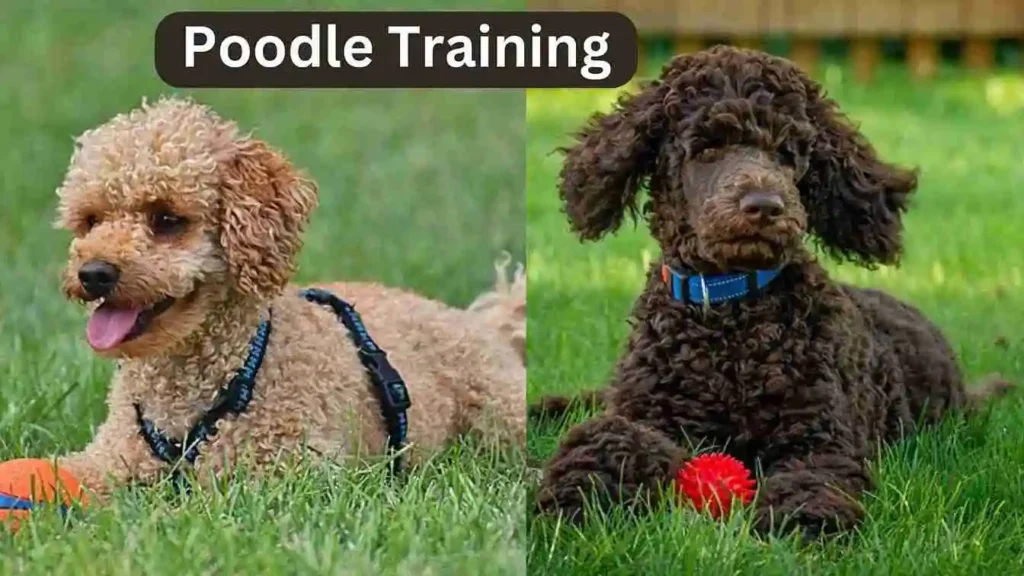Poodle Training 2024 – A Complete Guide

If you are curious about your poodle’s health and want to know the training steps that make them strong, healthy, and fit, then you are at the right place. Here, you will get the complete details about your poodle’s training.
Poodles are available in 4 sizes such as toy, miniature, standard, and Moyen poodle. All have different training steps to make them sharp and energetic. Let’s discuss their training steps one by one in detail to understand all the steps.
Basic Poodle Training Steps
Teach your Poodles to Stay
When you train your dog to sit, then move towards the next step, which is to teach him to stay. Hold a treat in your hand, but do not provide him and say ”stay” If he stays, then reward him with a treat. If he moves, then repeat the training until he learns to wait.
Teach your Poodle to Lie Down
For this purpose, take a treat in your hand while standing in front of your dog. Move your hand to the ground near your poodle head. The poodle eventually moves down for a treat and then says, “Lie down.” Repeat the practice many times until the poodle lies down on your order.
Teach your poodles their names
First of all, call your poodles with the name you choose for them. This step increases your poodles understanding. When they react and come towards you when you call their names, give them a some extra food as a gift. This reward increases their self-confidence and removes the fear of hesitation.
Teach your Poodles to Sit
For this purpose, take a treat in your hand while standing in front of your poodle. Move your hand to your chest and near your poodle head. The poodle suddenly sits on his bottom to get the treat, then says, “Sit.” Repeat this practice many times. When your poodle sits on your saying, then give him the treat.
Enroll your Poodle in Puppy Kindergarten
When your poodle is about 1 month or 1.5 months old, enroll them in a puppy kindergarten. This step is important because this age is very critical to making them socialize. Puppy kindergarten teaches your poodles how to socialize. They train your poodles by taking them in the company of others. This step also increases their self-confidence.
Not only will kindergarten perform this task, but you will also train your poodles to socialize with them. Expose your poodle to other people. Increase their communication skills.
Schedule Short Daily Training Sessions

As we know, poodles are very smart and active, but they need daily training sessions to remain healthy and fit. However, poodles become bored during long training sessions and start barking, so schedule a short training session.
A short training schedule is as follows:
In Morning
In Evening
6 – 8 am
Long Walk
5 pm to 6 pm
Training Time
9:30 am
Potty break
6 pm to 7 pm
Visit Dog Park
In Afternoon
In Night
1 PM
Give dry food
9 PM
Dinner time
3 PM
Playtime
10 PM
Potty break
| In Morning | |
| 6 – 8 am | Long Walk |
| 8:30 am | Breakfast |
| 9:30 am | Potty break |
| In Afternoon | |
| 1 pm | Give dry food |
| 3 pm | Playtime |
| In Evening | |
| 5 pm to 6 pm | Training time |
| 6 pm to 7 pm | Visit dog park |
| In Night | |
| 9 pm | Dinner time |
| 10 pm | Potty break |
Practice One Command at a Time
When you are training your poodle on basic commands, train him one command at a time. If you start multiple commands simultaneously, your poodle will never be taught. Such a mixture of commands confused your poodles.
Arrangements of commands
Teach your poodle these commands one by one, your poodle never get bored.
Keep your Training Consistent
Consistency is the key to success, so be consistent with your poodle training. When your poodle learns one basic command, like how to stay, don’t leave this training. Keep your every training step throughout your poodle’s life. In this way, the poodle never forgets any command and remains healthy and energetic.
Crate Training for a Poodle
When you have a miniature or toy poodle, buy a crate for them. The crate must be large enough that your poodle feels comfortable in it. There is enough space to stand and move in a crate. Train your poodles on how to stay in a crate.
Place your crate in a place where many people interact with them. This helps them to socialize and increase their self-confidence. You can also use a crate for a standard poodle, but it must be a large size.
Don’t leave your poodle alone until he is uncomfortable in a crate. When he is comfortable, then leave them but don’t for the whole day and night. Poodles need a daily walk also.
House Training Your Poodle
Start your poodle housetraining early, whether he is a toy, standard, or moyen. This training helps him to understand good habits.
Steps to Housetrain Your Poodle
The steps to housetrain your poodle are as follows:
Regular Training of Poodles
Daily Walk
Poodles require a daily walk of around 2 – 3 hours to remain healthy and fit. Daily walks are essential for humans as well as for poodles. This not only makes them physically fit but also socializes them. If you have free time, take your poodles for evening walks. Be consistent with your daily walk, as it is also beneficial for you.
Mental Stimulation
As discussed earlier, poodles are highly intelligent and wise, but their mental health requires regular exercise. Brain-challenging exercises are highly recommended. For this purpose, you can use puzzle toys, although some agility courses are also available. Such mental training activities make them sharp and active.
Friendly Behavior
Medium-sized poodles are very friendly. They are smart, intelligent, and have an excellent smelling sense. They may also serve as a security guard as they bark in case of any stranger. They play happily with children. Always adopt friendly behaviour with them, especially during training sessions, as it removes their hesitation.
Socialization
Make your poodles to be socialized. Try to interact with your poodles and other people. This social training enhances their communication skills. Leave your poodle in the company of other dogs, as this increases their self-confidence.
Leash Training Your Poodle
When you buy a poodle, either he is a toy, miniature, standard, or poodle, starts leash training sessions.
Steps to Leash Train Poodle
The steps of this session are as follows:
Guidelines for Poodle Owners
Positive Reinforcement
The main thing that helps your poodles to train early is your good behaviour. When your poodle obeys, you treat him to a meal. Don’t shout at your poodle in case of any mistake. Constantly positively reinforced them.
Patience and Persistence
Always remember that your poodle is not fully trained in a day or two. Training needs a specific time and regularity, so be patient and persistent. Celebrate small victories when your poodle is trained for any skill, and treat him with a meal.
Avoid Harsh Punishment
Don’t punish your poodles in case of any accidents. Always adopt soft behaviour with your poodles, as they are very sensitive creatures. Your harsh environment for your poodle leads to fear and anxiety.
Advanced Training of Poodles
Addressing Barking
Sometimes, poodles start barking spontaneously, so it is important to quiet them on your command. When they are barking, say, “Quiet.” If they stop barking, then treat them with a reward. Repeat this training every week.
Teaching Boundaries
Teach your poodle the boundaries of your house where he is allowed to go or not. Teach them with the command” leave it” or any other command you like. You can also teach them the boundaries of your society.
Target Training
Teach your poodle’s target training. This training helps them to target any object on the ground on your command. In this way, your poodle will become the best, and your communication skills will also increase.
Attention Training
It is often seen that poodles suffer from anxiety when the owner is away from them. This is due to the need for proper training. Attention training is required to solve this problem. Attention training is a type of training in which the owner teaches their poodle to stay alone without anxiety.
Teach Impulse Control
Teach your poodle how to control impulse and over-excitation. Sometimes, the poodle becomes over-excited and starts jumping. This over-excitation is not good for a poodle, so impulse control teaching is required.
Non Verbal Cues
As we discussed the verbal cues in detail, the nonverbal cues are also important, such as communicating with your poodle with a hand or any gesture. This training increases your poodle’s communication skills and understanding.
Release Cue
Teach your poodle a release cue such as “Ok.” This cue increases your poodles understanding. It also helps him to know whether he completed his action or not. It also stops him from doing any work.
Conclusion
Medium-sized poodles are very active and have a pleasing environment. They require friendly behavior, proper time, regular exercise, regular grooming, and a nutritional food diet. They are very sensitive and not very aggressive. These dogs are very social and tend to make their owners happy. If you want to buy a medium-sized poodle, note the above requirements because they are necessary for them. Let’s go and buy your poodle.
